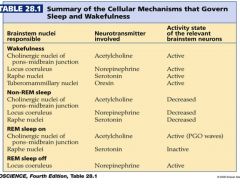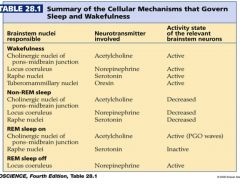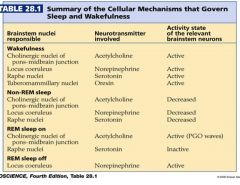![]()
![]()
![]()
Use LEFT and RIGHT arrow keys to navigate between flashcards;
Use UP and DOWN arrow keys to flip the card;
H to show hint;
A reads text to speech;
38 Cards in this Set
- Front
- Back
|
When sleeping, there are fluctuations in body temperature, GH and cortisol. How so for each?
|
Body temp lowers when sleeping.
GH peaks when sleeping. Cortisol peaks just before waking (and, for completeness, in the late afternoon too usually) |
|
|
What does "photoentrainment" refer to?
|
Synchronizing physiolgical processes with the day-night cycle, the biological clock must be able to detect light differences in the day-night cycle.
|
|
|
Photoentrainment is accomplished by retinal ganglion cells which contain this photopigment that are irradiance detectors that leads to depolarization by light.
|
melanopsin photopigment
|
|
|
Which nucleus is in charge of helping with the circadian cycle?
A. arcuate nuclei B. suprachiasmic nuclei C. supraoptic nuclei D. lateral nuclei |
B. suprachiasmic nuclei
|
|
|
Retinal ganglion cells [ deploarize / hyperpolarize ] in the presence of light.
|
THEY DEPLOARIZE!
note: cones and rods hyperpolarize in response to light; RGCs do the opposite – they depolarize! Also, RGCs have broad photosensitivities – not really concerned with what color but that there IS light or isn’t light present. |
|
|
What EEG wave type is present during:
"awake, alert, active processing of information 14-60 Hz, <1mV" A. alpha waves B. beta waves C. delta waves D. theta waves |
B. beta waves
|
|
|
What EEG wave type is present during: "quiet wakefulness, eye closed, relaxation/meditation 8-13 Hz 10-50mV"
A. alpha waves B. beta waves C. delta waves D. theta waves |
A. alpha waves
|
|
|
What EEG wave type is present during: "early stages of sleep 4-7 Hz 50-100mV"
A. alpha waves B. beta waves C. delta waves D. theta waves |
D. theta waves
|
|
|
What EEG wave type is present during: "deep sleep, 0.5 to 3 Hz 100-200 mV"
A. alpha waves B. beta waves C. delta waves D. theta waves |
C. delta waves
|
|
|
There is nonREM and REM sleep. What are the four stages during nonREM sleep?
|
Stage 1 = theta waves as we drift to sleep
Stage 2 = deeper sleep exhibiting sleep spindles (highly synchronous events) and K-complexes Stage 3 and 4= very slow, high amplitude delta waves |
|
|
During which stage(s) of nonREM sleep are theta waves present predominantely?
A. Stage 1 B. Stage 2 C. Stage 3 D. Stage 4 |
A. Stage 1
Wakefulness = alpha waves. As we drift into sleep, stage 1 with theta waves. Deeper into sleep is stage 2 with sleep spindles (highly synchronous events) and K-complexes Stage 3 and 4 = very slow, high amplitude delta waves. |
|
|
During which stage(s) of nonREM sleep are sleep spindles (highly synchronous events) and K-complexes present?
A. Stage 1 B. Stage 2 C. Stage 3 D. Stage 4 |
B. Stage 2
|
|
|
During which stage(s) of nonREM sleep are very slow, high amplitude delta waves present?
A. Stage 1 B. Stage 2 C. Stage 3 D. Stage 4 |
C. Stage 3
and D. Stage 4 |
|
|
From the time you fall asleep to the time you reach the deepest non-REM sleep, the amplitude of the waves [ diminishes / increases ] continuously, while their frequency [ diminishes / increases ].
|
wave amplitude = increases
frequency = diminishes |
|
|
Sleep architecture follows a pattern of alternating non-REM and REM (rapid eye movement) sleep throughout a typical night in a cycle that repeats itself about every ______.
A. 60 minutes B. 90 minutes C. 120 minutes D. 180 minutes |
B. 90 minutes
|
|
|
Non-REM sleep, in comparison to REM sleep, is characterized by an EEG in which the waves have a [ greater / lesser ] amplitude and a [ higher / lower ] frequency.
|
Waves have a greater amplitude and a lower frequency.
When the EEG looks like the awake stage, it's REM! |
|
|
Which stage(s) of non-REM sleep is described: " between being awake and falling asleep, light sleep".
A. Stage 1 B. Stage 2 C. Stage 3 D. Stage 4 |
A. Stage 1
|
|
|
Which stage(s) of non-REM sleep is described: " onset of sleep, becoming disengaged from surroundings, body temperature drops".
A. Stage 1 B. Stage 2 C. Stage 3 D. Stage 4 |
B. Stage 2
Remember: Stage 1 = Between being awake and falling asleep, Light sleep Stage 2 = Onset of sleep, Becoming disengaged from surroundings, Breathing and heart rate are regular, Body temperature drops |
|
|
________ in EEG reflect thalamocortical oscillations.
A. Sleep spindles B. K complexes |
A. Sleep spindles
|
|
|
_______ reflect outward flow of dendritic current from layers II/III of cortex. Think of them as interrupt signals.
A. Sleep spindles B. K complexes |
B. K complexes
synchronous reduction of cortical activity leads to membrane hyperpolarization or down states which aid in the generation of thalamocortical oscillations and sleep spindles. |
|
|
Which stage(s) of non-REM sleep is described: " deepest and most restorative stages of sleep, blood pressure drops, breathing becomes slower, muscles are relaxed, blood supply to muscles increase, tissue growth and repair occurs energy is restored, hormones are released".
A. Stage 1 B. Stage 2 C. Stage 3 D. Stage 4 |
C. Stage 3
D. Stage 4 note: stage IV is known as slow-wave sleep because of the prevalence of delta waves |
|
|
What percentage of the night, roughly, are we in REM sleep?
|
25%
|
|
|
True or False:
REM sleep first occurs about 90 minutes after falling asleep and recurs (4 times) about every 90 minutes, getting longer later in the night. |
True
|
|
|
Which of the following are NOT a feature of REM sleep?
A. increase in blood pressure, heart rate and respiration B. pupillary dilation C. diminished response to somatic stimuli D. paralysis of large muscle groups E. spontaneous penile erection F. dreaming G. blood supply to muscles increase |
B. pupillary dilation - pupillary CONSTRICTION occurs during REM sleep
G. blood supply to muscles increase - this is part of Stage 3 and 4 |
|
|
When are PGO waveforms observed?
A. Upon entering Stage 2 B. Upon entering Stage 3 C. Just prior to REM sleep D. At the beginning of REM sleep |
Late in Stage IV we get big giant PGO waveforms that occur as a prelude to the REM sleep.
C. Just prior to REM sleep |
|
|
True or False:
Brainstem nuclei that contain Ach and NE activate descending inhibitory connections that contain GABA to inhibit activity in the dorsal column nuclei. Glycine containing pathways will also be activated to inhibit lower motor neuron activity. |
True
|
|
|
Deep phases of non-REM sleep get a lot [ longer / shorter ] as the night progresses and the REM sleep gets a lot [ longer / shorter ].
|
non-REM = shorter; REM = longer as the night progresses.
We can skip phases and transitions but there seems to be an urge to get REM sleep. |
|
|
True or False:
Total amount of sleep decreases with age as does REM and slow wave (deeper) sleep. |
Unfortunately true.
|
|
|
Which of the following brainstem nuclei are responsible for wakefulness?
A. Cholinergic nuclei of pons-midbrain junction (reticular activating system, RACs) B. Locus coeruleus C. Raphe nuclei D. Tubermoammillary nuclei |

|
|
|
Decrease in the activity of which of the following brainstem nuclei are responsible for non-REM sleep?
A. cholinergic nuclei or pons-midbrain junction B. Locus coeruleus C. Raphe nuclei D. Tuberomammillary nuclei |

|
|
|
Activity of which of the following brainstem nuclei are responsible for REM sleep?
A. cholinergic nuclei or pons-midbrain junction B. Locus coeruleus C. Raphe nuclei D. Tuberomammillary nuclei |

|
|
|
Activity of which of the following brainstem nuclei are responsible for REM sleep off?
A. cholinergic nuclei or pons-midbrain junction B. Locus coeruleus C. Raphe nuclei D. Tuberomammillary nuclei |

|
|
|
Regarding the neural basis of sleep and wakefulness, _______ inhibits (via GABA) Tubero-Mammillary Nucleus and brainstem nuclei and promotes sleep.
|

VPLO, or ventrolateral preoptic nucleus
|
|
|
True or False:
Benzodiazepines decrease the effect of the GABA, and results in sedative, hypnotic (sleep inducing), anti-anxiety, anticonvulsant, muscle relaxant |
False!
Benzodiazepines ENHANCE the effect of GABA and results in sedative, hypnotic (sleep inducing), anti-anxiety, anticonvulsant, muscle relaxant. |
|
|
Why do antihistamines sometimes promote drowsiness?
|
Antihistamines inhibit the histaminergic neurons of the tuberomamillary nucleus, which, when active, promote wakefulness. Without em, promote drowsiness.
|
|
|
Difficulty falling and/or staying asleep. Can be a symptom of depression, jet-lag, stress, excessive caffeine or alcohol use, night shifts.
A. Insomnia B. Hypersomnia C. Parsomnia D. Sleep apnea |
A. Insomnia
|
|
|
Recurring episodes of sleep or excessive daytime sleepiness. Can be a symptom of narcolepsy, depression, sleep apnea, restless leg syndrome.
A. Insomnia B. Hypersomnia C. Parsomnia D. Sleep apnea |
B. Hypersomnia
|
|
|
Disruptive behaviors that arise due to arousals from REM sleep or partial arousals from Non-REM sleep, include bed-wetting, nightmares, night terrors, sleep-walking, and confusional arousals.
A. Insomnia B. Hypersomnia C. Parsomnia D. Sleep apnea |
C. Parsomnia
|

